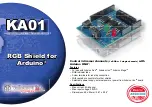
SWRU234b
October 2012
2.7 Antenna Performance
The
PCB
antenna
length
on
the
SmartRFCC1110-868 is tuned for optimal
performance with two AAA batteries present in
the battery holder. As this antenna is directive,
see
DN024
it
is
important to place the two nodes so that the
arrow in the silk print next to the antenna on
both boards points upwards towards the sky for
optimal performance.
2.8 Range testing
The preprogrammed link test is well suited for
range testing. Place the Slave in an open field
and bring the Master a known distance away.
Use the LED signaling to decide the link quality.
Note that the environment, antenna, etc greatly
affect
the
range,
see
DN018
2.9 Resetting the board
The recommended reset sequence is:
Remove jumper on P1 completely
Push one of the buttons to discharge the
large capacitor on the power line. If this
capacitor
is
not
discharged,
the
SmartRFCC1110-868 boards may continue
to run the current application until the
capacitor is discharged. This may take
several seconds.
Replace the jumper on P1 to power the
board again
3 Using the CC Debugger with the Development Kit
3.1 The CC Debugger
The CC Debugger connects to the PC via a mini USB and uses the
DEBUG interface to communicate with the radio. The tool can be used
for:
Programming the flash and debugging an application running on the
CC1110. The PC tools available for these purposes are the
SmartRF Flash Programmer from Texas Instruments and IAR
Embedded Workbench for 8051 from IAR Systems.
Testing the radio performance of CC1110 using SmartRF Studio.
For more details, ple
ase refer to the CC Debugger User’s Guide
and the CC1110 & CC2510 Mini Development
3.2 SmartRF Studio
SmartRF Studio can be used for RF testing, evaluation of CC1110 and to
find optimal register settings. It is available on
3.3 Flash Programmer
The Flash Programmer application, available on the kit web page
http://focus.ti.com/docs/toolsw/folders/print/flash-programmer.html
can
be used to program Intel HEX files, read the contents of CC1110 flash,
and several other operations.
3.4 IAR Embedded Workbench
To develop software, program and debug the CC1110, the IAR
Embedded Workbench for 8051 is recommended. An evaluation version
of IAR EW8051 is included in the kit. This free evaluation version and a
free code size limited version, can be downloaded from the web, see
A. Available Software and User’s Guides
CC1110 & CC2510 Mini DK Software Example User’s Guide and
Source Code
Source and documentation for the link test for the SmartRFCC1110
target board
CC1110 & CC2510 Mini De
velopment Kit User’s Guide
More documentation and details on the use of the SmartRFCC1110
target board
CC1110, CC2510 Basic Software Examples
Source
code
for
other,
simple
examples
for
the
CC1110
SimpliciTI™ Network Protocol
An
RF
protocol
targeting
simple,
small
RF
networks
B. More information
The Low Power RF Online Community
forums, blogs and videos. Use the forums to find information, application
and design notes, FAQs, or to discuss and get help with your design.
On the Texas Instruments’ Low-Power RF web site
, you
will find all our latest products, news and events updates, and much
more.
The TI LPRF eNewsletter keeps you up to date on e.g. new products,
application
notes,
software
and
events.
Sign
up
at
We hope you will enjoy working with the CC1110 Mini Development Kit
and associated Low-Power RF products from Texas Instruments.
Note that there should only be one active power source at any one
time.























